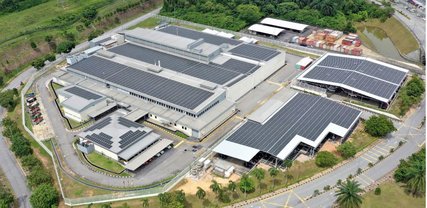

G+D and UN Global Compact – Greener Banknotes
With a climate goal of a 25% reduction in CO2 emissions by 2022 (base year 2016), Giesecke+Devrient (G+D) and its papermaking and feature subsidiary Louisenthal state that they are making a significant contribution towards climate protection – surpassing the goal, and achieving a reduction of 32% in 2020.
The company has been committed to the principles of the UN Global Compact on human rights, labour standards, protecting the environment and fighting corruption since 2010, and at the end of 2020 became one of 24 German companies to participate in the UN’s Sustainable Development Goals Ambition Initiative. It published its annual progress report on 24 April to coincide with Earth Day 2021, stating that it is taking action on different environmental issues and embracing its responsibility to reduce its ecological footprint. This includes product innovations that minimise resource consumption and promote recycling, for instance by introducing payment card bodies made of 100% recycled material.

The continuous reduction of greenhouse gas emissions is being achieved by streamlining production processes and moving towards more inhouse green power generation. In its production across all business sectors, G+D is steadily transitioning to renewable energy – increasingly selfgenerating sources – and implementing a range of efficiency measures.
In 2020, it completed a major project in the renewable energy field, namely at its banknote printing facility in Malaysia, where solar panels were installed across an area of 9,000 m². The investment in solar energy is helping make banknotes greener by reducing the carbon footprint for the printing of both paper and polymer banknotes by more than 1,000 metric tons per year. The solar panels were connected to the grid in December 2020, with the electricity also being fed into the public power network.
Louisenthal’s paper mill has also reduced the carbon footprint of cotton-based banknote manufacture by generating renewable energy from a dedicated hydropower system for many years, and operates a heat recycling network on its site. In mid-2020, it commissioned a new air-water heat exchanger. The heat achieved results in an annual saving in natural gas of at least one million kilowatt hours, while CO2 emissions are reduced by 200 metric tons a year.
In recent years, the paper mill has invested around €15 million in energy efficiency and climate protection measures in the field of banknote paper and foil manufacturing. Members of the International Association of Currency Affairs (IACA) recognised this commitment to sustainability in 2020, with Louisenthal winning the the inaugural Best New Environmental Sustainability Project award. When it comes to the product lifecycle, G+D is increasingly taking account of sustainability factors with leading issuers such as the ECB. Its banknote paper is typically manufactured from cotton comber noil – a waste product from the production of yarns in spinning mills that is also available from organically grown cotton if the customer prefers. Louisenthal is the largest manufacturer of banknotes made from organic cotton.
More information on G+D´s sustainability activities and corporate responsibility can be found here:

Further Reading
The Life of a Banknote
Louisenthal is running the Life of a Banknote program to promote tangible action for green banknotes, including the use of green energy, fair-trade cotton, reusable packaging and recycling. Did you know we produce 25% of our own electricity and have reduced water consumption by 40% in 9 years?